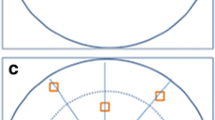Abstract
Biodiversity monitoring surveys are rarely optimised statistically before being initiated. Here, we optimised the monitoring of plants in a temperate forest. The total inventory cost, the number and size of quadrats were optimised to detect a 10% change in species richness over 5 years with α = β = 0.05, using data from ongoing long-term floristic monitoring programs. The procedure showed that the inventory cost would be ca 15% lower using 100-, 200-m2 quadrats instead of 300- or 400-m2 quadrats. Despite the cost associated with the optimisation (e.g. gathering preliminary data) and the imprecise estimates (due to the typically small sample size of the pilot studies), optimisation would often be a better option than expert opinion when designing a monitoring survey.
Similar content being viewed by others
References
Archaux, F., Gosselin, F., Bergès, L., & Chevalier, R. (2006). Effects of sampling time, quadrat richness and observer on exhaustiveness of plant censuses. Journal of Vegetation Science, 17, 299–306.
Baguley, T. (2004). Understanding statistical power in the context of applied research. Applied Ergonomics, 35, 73–80.
Bartsch, L. A., Richardson, W. B., & Naimo, T. J. (1998). Sampling benthic macroinvertebrates in a large flood-plain river: considerations of study design, sample size, and cost. Environmental Monitoring and Assessment, 52, 425–439.
Camaret, S., Bourjot, L., & Dobremez, J.-F. (2004). Suivi de la composition floristique des placettes du réseau (1994/95–2000) et élaboration d’un programme d’assurance qualité intensif. Office National des Forêts, Fontainebleau, France.
Carlson, M., & Schmiegelow, F. (2002). Cost-effective sampling design applied to large-scale monitoring of boreal birds. Conservation Ecology, 6, 2–11.
Cohen, J. (1988). Statistical power analysis for the behavioral sciences. 2nd edn,. New Jersey: Lawrence Erlbaum.
Di Stefano, J. (2003). How much power is enough? Against the development of an arbitrary convention for statistical power calculations. Functional Ecology, 17, 707–709.
Dupont, W. D. (1988). Power calculations for matched case-control studies. Biometrics, 44, 1157–1168.
ECC (1979). Birds Directive 79/409/ECC on the conservation of wild birds. Belgium: Brussels.
ECC (1992). Habitats Directive 92/43/ECC on the conservation of natural habitats and of wild fauna and flora. Belgium: Brussels.
ECC (1998). European Community Biodiversity Strategy, Communication COM (98) 42. Belgium: Brussels.
Evans, T. D., & Viengkham, O. V. (2001). Inventory time-cost and statistical power: a case study of a Lao rattan. Forest Ecology and Management, 150, 313–322.
Hatch, S. A. (2003). Statistical power for detecting trends with applications to seabird monitoring. Biological Conservation, 111, 317–329.
Heidelbaugh, W. S., & Nelson, W. G. (1996). A power analysis of methods for assessment of change in seagrass cover. Aquatic Botany, 53, 227–233.
Hochbichler, E., O’Sullivan, A., van Hees, A., & Vendekerkhove, K. (2000). Cost Action E4: forest reserves research network. Recommendations for data collection in forest reserves, with an emphasis on regeneration and stand structure. Final report of working group II. European Forest Institute, Joensuu, Finland.
Kendall, W. L., Peterjohn, B. G., & Sauer, J. R. (1996). First-time observer effects in the North American breeding bird survey. Auk, 113, 823–829.
Kirby, K. J., Bines, T., Burn, A., Mackintosh, J., Pitkin, P., & Smith, I. (1986). Seasonal and observer differences in vascular plant records from British woodlands. Journal of Ecology, 74, 123–132.
Klimeš, L., Dancák, M., Hájek, M., Jongepierová, I., & Kucera, T. (2001). Scale-dependent biases in species counts in a grassland. Journal of Vegetation Science, 12, 699–704.
Klironomos, J. N., Rillig, M. C., & Allen, M. F. (1999). Designing belowground field experiments with the help of semi-variance and power analyses. Applied Soil Ecology, 12, 227–238.
Legendre, P. (1993). Spatial autocorrelation: trouble or new paradigm? Ecology, 74, 1659–1673.
Legendre, P., Dale, M. R., Fortin, M. J., Gurevitch, J., Hohn, M., & Myers, D. (2002). The consequences of spatial structure for the design and analysis of ecological field surveys. Ecography, 25, 601–615.
Lovell, B., McKelvie, I. D., & Nash, D. (2001). Sampling design for total and filterable reactive phosphorus monitoring in a lowland stream: considerations of spatial variability, measurement uncertainty and statistical power. Journal of Environmental Monitoring, 3, 463–468.
Scott, W. A., & Hallam, C. J. (2002). Assessing species misidentification rates through quality assurance of vegetation monitoring. Plant Ecology, 165, 101–115.
Stohlgren, T. J., Falkner, M. B., & Schell, L. D. (1995). A Modified-Whittaker nested vegetation sampling method. Vegetatio, 117, 113–121.
Van der Meer, J. (1997). Sampling design of monitoring programmes for marine benthos: A comparison between the use of fixed versus randomly selected stations. Journal of Sea Research, 37, 167–179.
Author information
Authors and Affiliations
Corresponding author
Rights and permissions
About this article
Cite this article
Archaux, F., Bergès, L. Optimising vegetation monitoring. A case study in A French lowland forest. Environ Monit Assess 141, 19–25 (2008). https://doi.org/10.1007/s10661-007-9874-0
Received:
Accepted:
Published:
Issue Date:
DOI: https://doi.org/10.1007/s10661-007-9874-0




